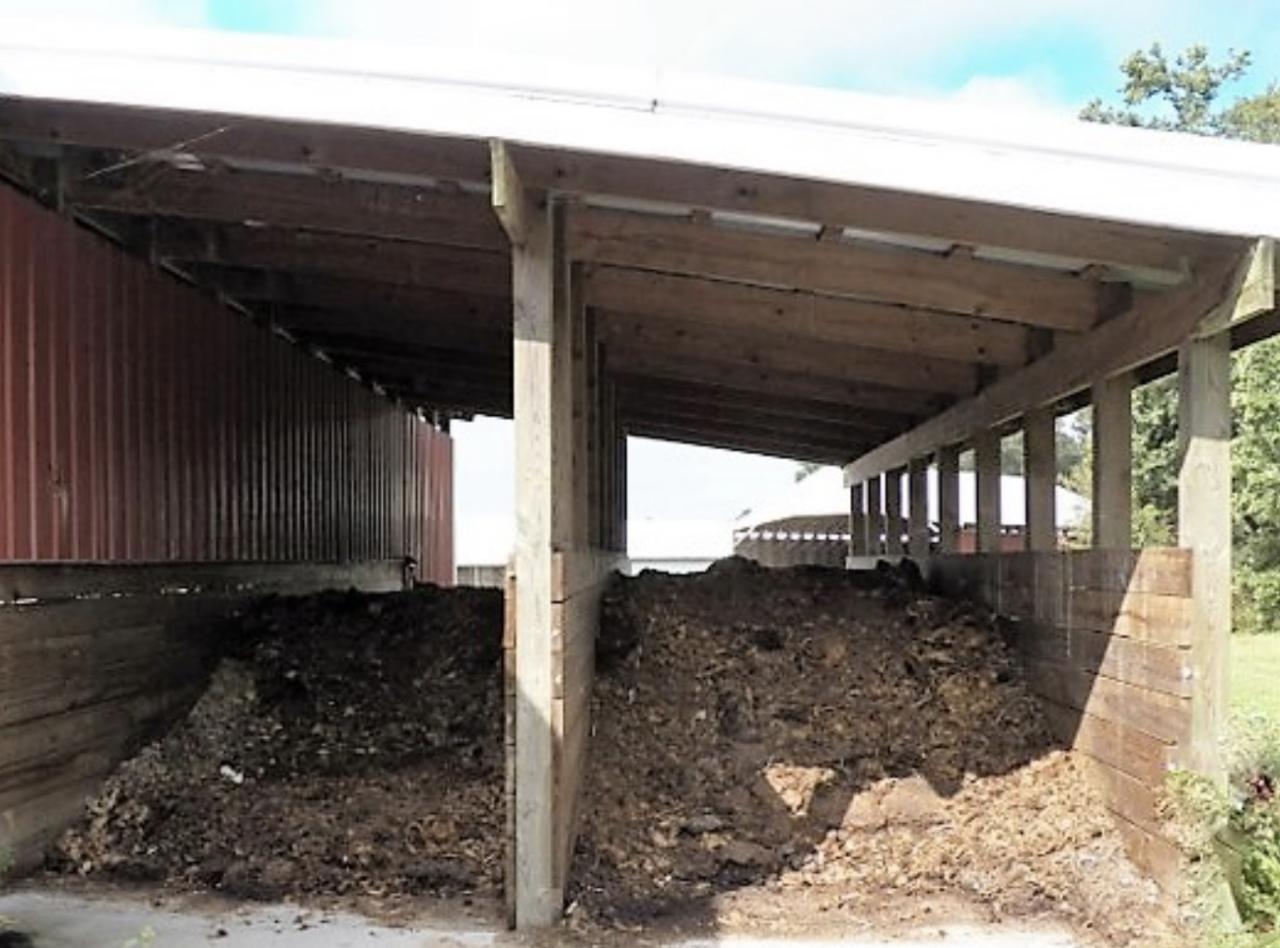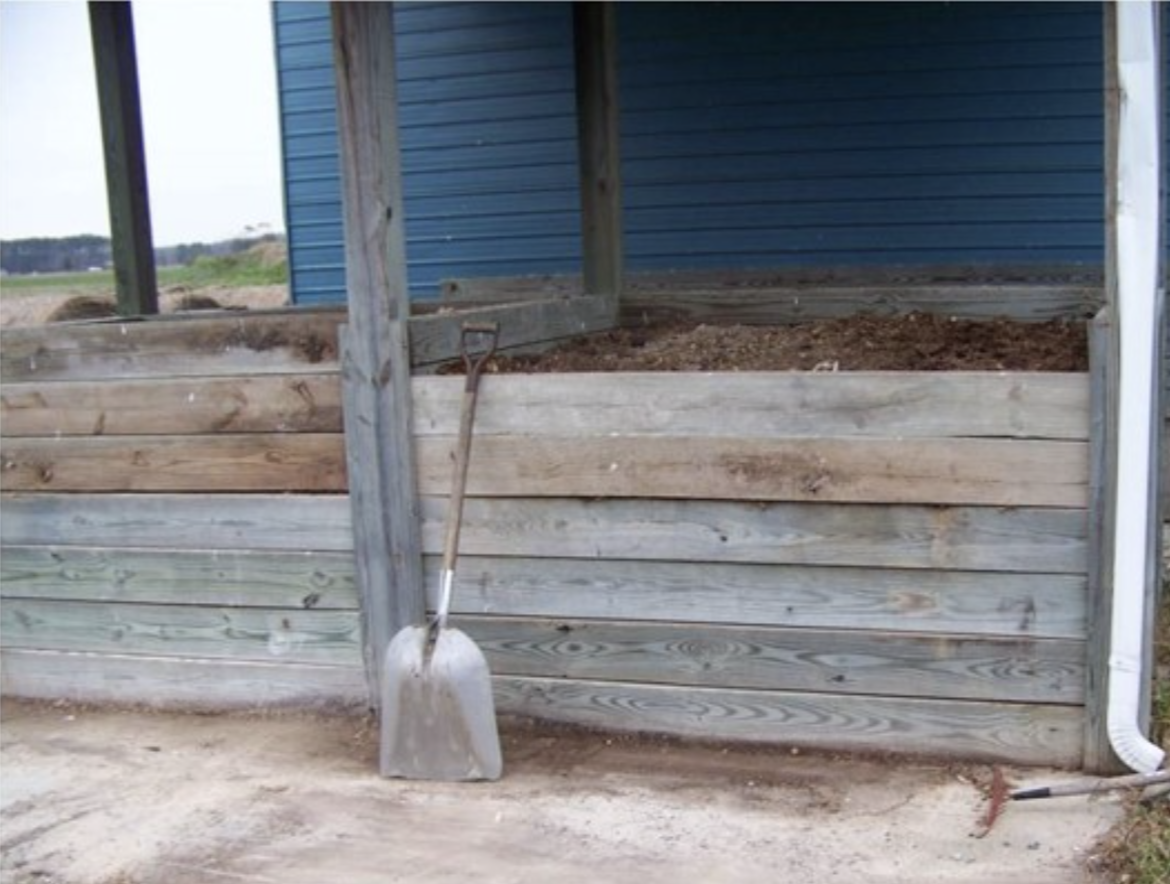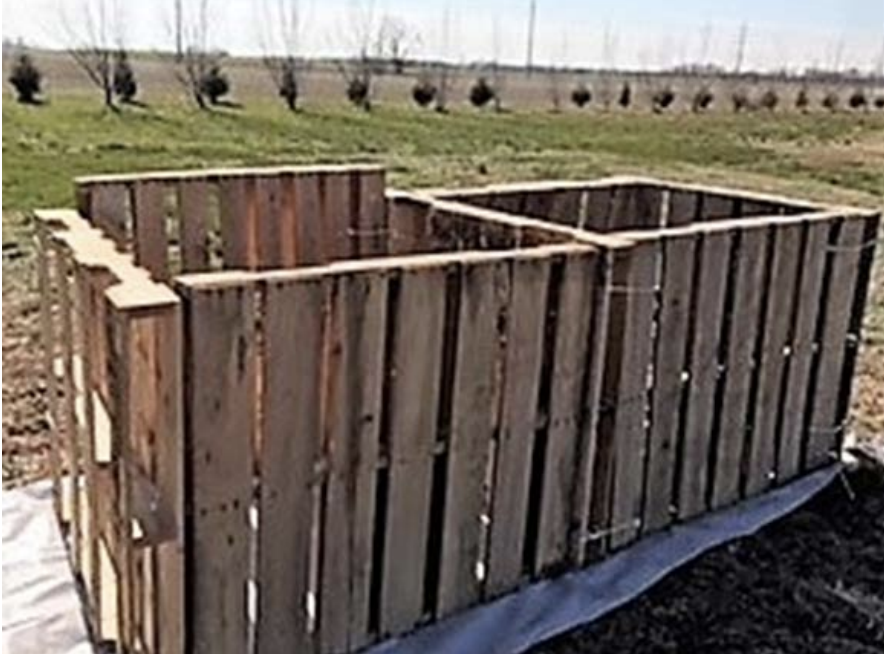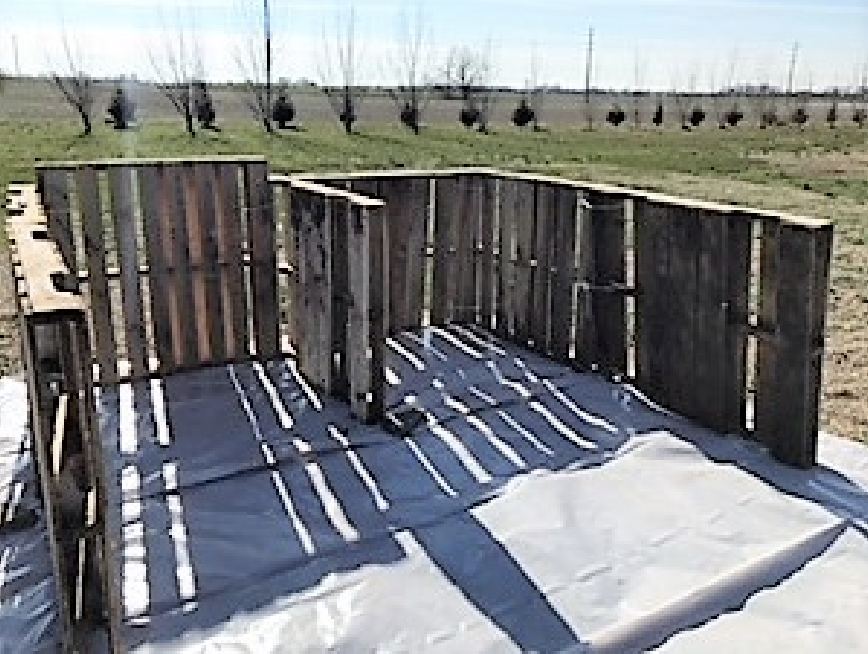
Fact Sheets And Publications

Temporary Mortality Management on New Poultry Farms
May 2025 | Written by Sydney Y. Riggi, Georgie M. Cartanza, and Amy L. Shober
Introduction
Commercial poultry operations are required to implement mortality management practices to comply with State and Federal regulations. New operations are unable to apply for financial assistance to offset the costs of establishing permanent mortality management structures (e.g., composting units, in-vessel composters) until they are actively raising chickens. Once growers are able to apply for assistance, approval for funding to install permanent mortality management structures may be months or longer. This factsheet outlines suggested temporary routine mortality practices by guiding new poultry growers through the five-step process of creating a temporary composter. A temporary composter is designed to handle routine mortalities during the period between when production begins and permanent routine mortality management structures are installed.
These temporary mortality management practices are meant to be used for a short period of time; they are not meant to be permanent solutions for managing mortalities on a poultry farm. Permanent structures should be implemented as soon as funding is secured, as the efficiency of permanent structures is supported by years of scientific data.
Step 1: Temporary Composting Location
Select a location for the temporary composting area that: 1) will not be the location of the permanent composting structure, 2) does not flood, and 3) is in close proximity to the poultry houses. The temporary composting site should be located outside the work zone, which includes roadways used for live haul, feed, fuel, and chick delivery.
The temporary composting area should also be located away from public roadways, surface water, wells, private residences and follow all local, State and Federal regulations. We recommend following the minimum setback distances for temporary field staging of poultry litter as outlined in the Delaware Nutrient Management Law (3 Del. C. § 2247) and the Regulations (3 Del. Reg. 1201) when siting the temporary composting area. The temporary composting area should be located at least:
100 feet from a public road
100 feet from surface water
200 feet from a private well
300 feet from a public water supply well
200 feet from any residence not on your property
Growers should also be mindful of the odors that are produced during the composting process and consider odor issues when choosing the temporary composting site. Being mindful of odors and other production related issues will help growers establish good relationships with their neighbors and make them a good representative of the poultry industry.
Step 2: Choosing a Temporary Bin or Channel Composting Structure
There are two standard types of composters: bin composters and channel composters. A bin composter consists of a series of self-contained cubes (or bins) where mortalities are composted (Figure 1). Material within the bin composter must be turned frequently during the heating and cooling stages of the composting process.
In contrast, channel composters have one or multiple channels that are open on one or both ends and are typically deeper than the individual cubes used in the bin composter (Figure 2). The channel composter design allows for an alley or windrow shaped pile of compost material. The channel is filled starting at one end. After the channel is full, the material is allowed to complete the first heat. Then the material is removed to storage to complete the composting process. Consideration should be given where to place the “second heat” and finished compost material. Temporary covered storage for finished compost may be needed until field application is possible.

The choice between constructing a bin or channel composter will likely depend on the availability of equipment to manage the composting process. Bin composters are a better choice for operations with smaller equipment, while channel composters are a better choice for operations using equipment like a front-end loader.
Step 3: Sizing the Temporary Composting Structure
Sizing the temporary composter is challenging because growers may not know when a permanent structure will be built. We recommend sizing the temporary composting structure to handle routine mortalities for one flock of chickens with a finishing weight of 8.5 lbs (Table 1). For example, 16 bins that are 5 feet × 6 feet × 7.29 feet (219 cubic feet) are needed to temporarily manage routine mortality for one flock at a 120,000 bird capacity farm. We recommend constructing a few bins or channels initially, adding more structures as needed.
Step 4: Building the Structure
Temporary composters should be built as a freestanding structure (Figures 3 and 4). Due to the high water table in many parts of Delaware, we recommend installing a barrier between the compost material and the ground. The base of the structure should be impervious to water and could be a concrete pad (that was previously used for another purpose), a compressed clay pad, or a plastic liner with a minimum thickness of 10 mil; the base should cover the entire footprint of the area. Concrete or compacted clay pads are preferred over plastic liners because the use of a plastic liner could make cleaning out the compost area challenging. Use caution when turning or removing the compost materials on a plastic liner. If the plastic liner is damaged when cleaning out the temporary composter, it will need to be replaced before the temporary composter can be put back into operation.
Growers should also keep in mind the size of the equipment they will be using for composting when building the temporary structure. The structure should be built 12 inches wider than the available equipment. When using pallets to construct a bin composter, the corners will need to be secured. One inexpensive way to do this is to use a studded t-post and wire. Caution should be used when filling the structure because walls may not withstand the load when full or being pushed against with equipment. Construct vermin proof wire gates and covers to secure the mortalities from scavengers while the composting process is taking place. A galvanized steel mesh (rat wire) is suitable for use as a cover.

Step 5: Composting Materials and Tools
The goal of composting is to create a suitable environment for microbial activity, as it is this microbial activity that facilitates decomposition and composting. Microbes need the right amount of carbon (C), nitrogen (N), oxygen (O), and water for composting to occur.
The following materials and tools are required to provide an environment that will support adequate microbial activity:
Carbon Source: Poultry carcasses are a low carbon material. Carcasses must be mixed with a high carbon material to achieve the right ratio of carbon to nitrogen for proper composting. The carbon to nitrogen (C:N) ratio of the compost should be maintained between 15:1 and 35:1 (Donald et al., 2008). Most “recipes” for composting poultry mortalities call for layering the mortalities between poultry litter (the preferred high carbon material). However, new producers may not have access to an adequate supply of poultry litter. Growers who opt to find an alternative source of litter should follow strict biosecurity practices. The use of cake or crust is not recommended for composting mortalities. Cake or crust is a dense material, which does not have the needed pore space to provide oxygen for microorganisms. If litter is not available, we recommend that wood shavings be used in place of poultry litter.
Thermometer: Heat will be produced as the microbes decompose the poultry carcasses. In two to four days, the compost should reach temperatures between 135° and 150° F (Murphy & Carr, 1991). In fact, the production of heat is the key indicator that composting is occurring. As such, monitoring compost with a thermometer is an excellent way to monitor composting activity. Composting thermometers are available in a wide range of lengths. A thermometer with a minimum length of 36 inches is recommended to monitor the temperature or trouble shoot the process if needed (Donald et al., 2008).
Water Source: The microorganisms that break down the poultry carcasses need water to function. Therefore, having a water source near the temporary composting area is critical to managing the composting process. The moisture content of the compost should be between 40 and 60% (Donald et al. 2008). One of the most common problems composting poultry mortalities is that the compost material is too wet or too dry. Caution should be used when adding water, it is usually not necessary for composting poultry mortalities. Compost that does not heat up or has a bad smell is probably too wet; if this occurs, turn the pile to aerate.
Cover or composting fleece: Compost material in the temporary structure should be covered to reduce the risk of nutrient loss and help control the moisture level of the composting materials. There are a variety of covers available, ranging from a simple tarp to specialized composting fleece or fabric. Composting fleece or fabric is a covering that sheds rainwater and snow but also allows for air exchange.
Front-end Loader: A front-end loader is needed to turn the compost. Once the compost goes through the first heat cycle, the pile will need to be turned to generate a second heat cycle so the carcasses can continue to break down because the edges of the compost pile do not get as hot as the center of the pile.
| Total Birds Placed per Flock | Number of Free Standing Bins Required | Single Row Channel Composter | Two Row Channel Composter | ||
|---|---|---|---|---|---|
| Length | Sq. Ft. | Length | Sq. Ft. | ||
| 10,000 | 2 | 12 | 138 | 12 | 192 |
| 20,000 | 2 | 16 | 184 | 16 | 256 |
| 30,000 | 4 | 24 | 276 | 20 | 320 |
| 40,000 | 4 | 28 | 322 | 20 | 320 |
| 50,000 | 6 | 32 | 368 | 24 | 384 |
| 60,000 | 8 | 36 | 414 | 28 | 448 |
| 70,000 | 8 | 44 | 506 | 32 | 512 |
| 80,000 | 10 | 48 | 552 | 36 | 576 |
| 90,000 | 12 | 52 | 598 | 40 | 640 |
| 100,000 | 12 | 60 | 690 | 44 | 704 |
| 110,000 | 14 | 64 | 736 | 48 | 768 |
| 120,000 | 16 | 68 | 782 | 52 | 832 |
| 130,000 | 16 | 72 | 828 | 56 | 896 |
| 140,000 | 18 | 80 | 920 | 60 | 960 |
| 150,000 | 20 | 84 | 966 | 64 | 1024 |
| 160,000 | 20 | 88 | 1012 | 68 | 1088 |
| 170,000 | 22 | 96 | 1104 | 68 | 1088 |
| 180,000 | 24 | 100 | 1150 | 72 | 1152 |
| 190,000 | 24 | 104 | 1196 | 76 | 1216 |
| 200,000 | 26 | 108 | 1242 | 80 | 1280 |

Biosecurity
Properly composting mortalities is necessary to maintain biosecurity. Diseases and pest larvae are controlled when mortalities are composted properly. This means that the compost must be managed properly (i.e., allowing enough time to compost, turning the compost pile) to ensure proper heating. It is important to place mortalities a minimum of six inches away from the edge or top of the compost pile. Proper placement of carcasses within the compost pile will ensure that they will go through a proper heating cycle. Also, turning the pile will ensure that any edge areas that did not get hot enough through the first heat will be exposed to heat after the pile is turned.

Composting Resources
Composting is both an art and a science and it will take some practice to get comfortable with the composting process. The primary factors that affect composting are C:N ratio, temperature, oxygen, moisture, and pH. A detailed look at the composting process is available in the University of Maryland publication Composting Dead Birds (Murphy & Carr, 1991).
Troubleshooting may be necessary if there are issues, such as mortalities not composting in a timely manner, seepage from the composting area, or a large number of flies. More information related to troubleshooting the composting process is available in the Virginia Tech publication Trouble Shooting Poultry Mortality Composters (Collins, 2009).
Planning is key to any poultry operation. New poultry operations should have a nutrient management and biosecurity plan that addresses routine and catastrophic composting practices. During a catastrophic mortality loss, growers will need to manage a large number of mortalities in a short period of time. A comprehensive guide to composting a catastrophic loss is found in the University of Maryland publication Composting Catastrophic Event Poultry Mortalities (Carr et al., 1998).
Final Considerations Related to Temporary Composting Structures
In this fact sheet, we outlined temporary practices for managing routine poultry mortalities. The structures described in this publication are not designed to withstand long-term use or extreme weather conditions. Growers should remain engaged in the process to construct permanent composting facilities on their farms to enable long-term management of routine mortalities.
References
Carr, L. E., Broide, H. L., John, H. M., Malone, G. W., Palmer, D. H., & Zimmermann, N. (1998). Composting catastrophic event poultry mortalities (Fact Sheet 723). University of Maryland & Maryland Cooperative Extension. https://enst.umd.edu/sites/enst.umd.edu/files/files/documents/Extension/Comp-Poultry_FS-723.pdf
Collins, E. R., Jr. (2009). Troubleshooting poultry mortality composters. Communications and Marketing, College of Agriculture and Life Sciences, Virginia Polytechnic Institute and State University. https://vtechworks.lib.vt.edu/server/api/core/bitstreams/69eb9875-7af0-4415-a843-4a173be789fb/content
Donald, J. O., Mitchell, C. C., & Payne, V. (2008). Dead poultry composting (ANR-558). Alabama Cooperative Extension System, Alabama A & M and Auburn Universities. http://www.aces.edu/pubs/docs/A/ANR-0558/index2.tmpl
Murphy, D. W., & Carr, L. E. (1991). Composting dead birds (Fact Sheet 537). Maryland Cooperative Extension. https://enst.umd.edu/sites/enst.umd.edu/files/files/documents/Extension/Comp-Birds_FS-537.pdf
Nutrient Management, Delaware Administrative Code Title 3 Section 22. (3 Del. C. §§ 2201-2290). https://delcode.delaware.gov/title3/c022/index.html
Nutrient Management Certification Regulations, _D.E. Administrative Code, Title 3, § 1201. (23 DE Reg. 1201). https://regulations.delaware.gov/AdminCode/title3/1200/1201.shtml#P2_24
Rynk, R., Van der Kamp, M., Willson, G. B., Singley, M. E., Richard, T. L., Kolega, J. J., & Brinton, W. F. (1992). On-farm composting handbook. Natural Resource, Agriculture, and Engineering Services.
USDA Natural Resources Conservation Service. (2001). Delaware conservation practice standard composting facility. https://agriculture.delaware.gov/wp-content/uploads/sites/108/2017/12/CompostingFacility.pdf
USDA Natural Resources Conservation Service. (2015, September). Field office technical guides conservation practice standard animal mortality facility. https://agriculture.delaware.gov/wp-content/uploads/sites/108/2017/12/AnimalMortalityFacility.pdf
About the Authors
Sydney Y. Riggi (corresponding author), Nutrient Management Extension Agent, University of Delaware Extension, Dover, DE
Georgie M. Cartanza, Poultry Extension Agent, University of Delaware Extension, Georgetown, DE
Amy L. Shober, Professor and Extension Specialist, University of Delaware, Newark, DE (ashober@udel.edu)
About this Publication
Original publication date: 2018
Revision date(s): 2025
Peer Reviewers
Ann P. Baldwin, P.E. USDA-NRCS, Dover, DE.
Gary Flory, Virginia Department of Environmental Quality, Harrisonburg, VA
UD Cooperative Extension
This institution is an equal opportunity provider.
In accordance with Federal law and U.S. Department of Agriculture policy, Cooperative Extension is prohibited from discriminating on the basis of race, color, national origin, sex, age, or disability.
